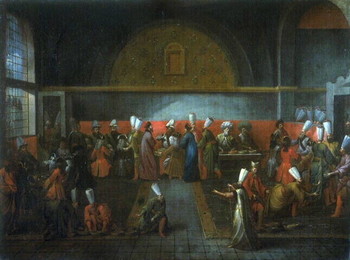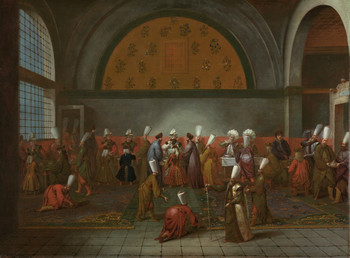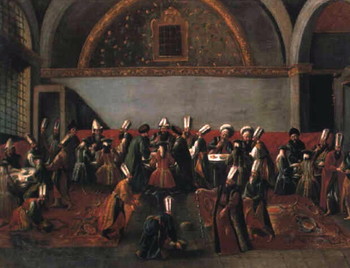Jean Baptiste Vanmour
Reception in Constantinopel of the French Ambassador, Viscount d’Andrezel, by the Grand Vizier, Ibrahim Pacha, 17/10/1724
Oil on canvas : 90 X 121,5 cm
Unsigned, 1724
Bordeaux, Musée des Beaux-Arts
This is a comparative item

Painting for Sale
In short
This 19th century Turkish painting is inspired by paintings made by the Flemish painter Jean Baptiste Vanmour in Istanbul in the first half of the 18th century. Vanmour, who lived and worked for almost 40 years there, painted several of these diner scenes where the Ottoman Prime Minister (Grand Vizier Ibrahim Pasha) invited a foreign Western ambassador.
About Jean Baptiste Vanmour
French painter of Flemish origin
Valenciennes 1671 – 1737 Istanbul
Painter of the Turkish court life and of portraits.
Son of a 21-year old cabinetmaker from Valenciennes, halfway Brussels and Paris. The town belonged, just like Flanders, to the Spanish Habsburg empire. In 1677 it was taken by Vauban, at the service of King Louis XIV. The Treaties of Nijmegen of 1678/79 have confirmed it belonging to France (which of course it still does). Until the end of his life, he died at the age of 66, Vanmour was known as a Flemish painter from Valencijn (Valenciennes in Flemish).
Very little is known of Vanmour’s life in France prior to his arrival in Istanbul in 1699. He must have met the new French ambassador, Charles de Ferriol d’Argental, in Paris and must have travelled at his demand with him to Turkey. In those days one travelled per ship from Marseille.
When de Ferriol returned to France in 1711 Vanmour remained in Istanbul, at the service of other diplomats, especially of the next five French ambassadors. In those days some 600 à 700.000 people were living in the Turkish capital. The census of 1723 of French citizens there counted 360 Frenchmen; Vanmour was not married and had no children.
And, though it is clear that Vanmour used several assistants to help him paint, none of these were French. It is not known if they were Western European (probably not), Greek, Armenian or Turkish?
Vanmour did not only paint for French ambassadors or for the French Ministry of the Navy, but also for some other Western ambassadors, there were eleven at that time, especially for the Dutch ambassador Cornelis Calcoen (1725 – 1743). The collection of Calcoen is today at the Rijksmuseum of Amsterdam.
In 1725 Vanmour was given the title of Ordinary Painter of the King in the Levant.
Upon arriving in Istanbul Vanmour witnessed the last years of the reign of Sultan Moustapha II (1695 – 1703). He was succeeded by Sultan Ahmet III (1703 – 1730). Under his Grand Vizier Ibrahim Pasha (1718 – 1730) Turkey opened to the West (the so-called Tulip period). Ahmet III was succeded by Sultan Mahmud I (1730 – 1754).
About our painting
Vanmour, who stayed for almost 40 years in Istanbul, was well introduced at the court. Ottoman court ceremonials were strictly regulated, but still Vanmour was able to accompany ambassadors who were received by the Sublime Porte (the imperial council) at the Topkapi Serayi and to make sketches, which served to make large paintings at his studio.
These ceremonials followed a very strict order, which remained almost unchanged between the 15th and the 19th century. Vanmour, helped by his assistants, painted several versions for different ambassadors by changing just a few details and portraits within very similar compositions. I found four different paintings attributed to Jean Baptiste Vanmour representing most probably each time Grand Vizier Ibrahim Pasha giving a diner in honour of a Western ambassador at the Topkapi Palace. Under this Prime Minister of Sultan Ahmet III Turkish court life was known for its extravagant garden parties and sumptuous entertainment: it was called the “Tulip period”.
Our painting is clearly inspired by these four paintings, and maybe by another unknown version.
At the centre sits the ambassador on a low stool in front of the Prime Minister. Left and right of him stand two “dragomans”, interpreters: one of the Porte and one of the embassy (controlling each others translations). The other figures in these compositions represent assistants of the ambassador (the chancellor, secretary) and important Turkish officials (ministers, the treasurer). Food was served in silver dishes with an ivory spoon.
Why should you buy this painting?
Because it remains an exotic and interesting proof of the relationship between the West and the Sublime Porte, despite a certain naivety.
Comparative paintings
Click photos for more details





